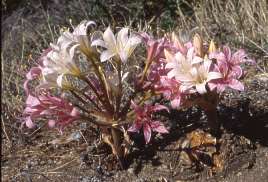Ammocharis longifolia
Ammocharis longifolia (L.) M.Roem.
Family: Amaryllidaceae
Common names: Malgas lily (Eng.); seeroogblom (Afr.)
Introduction
The name Malgas lily is taken from the abundance of this bulb in the Malgas area near the Breede River in the Cape. It is one of South Africa's showiest bulb species especially when seen flowering en masse.

Description
Description
The plants are deciduous and grow in winter. The leaves appear from May and die back from October when the plants normally come into flower. They have a cut-off appearance at the tips. The bulbs are large at maturity, 100-150 mm in diameter, with a neck of about 60 mm long.
The 9 to 14 leaves are green or dry when the plant flowers. The leaves curve sideways, vary in length, and are 13-55 mm wide. The flowers are tubular, funnel-shaped, ivory to deep pink, 8-15 mm long, with stamens exserted from the tubes. Flowers are normally born from December to April and produce a strong and pleasant frangipani-like scent. The fruits are more or less spindle-shaped with papery walls that disintegrate upon ripening. Seeds are greenish, fleshy and subglobose, 5-30 mm in diameter. The pedicels in the fruiting head elongate and spread outwards, making a ball which tumbles in the wind, distributing the seeds. From seed, plants grow relatively slowly and take about seven years before flowering.
Distribution and habitat
Distribution description
Plants are restricted to the winter-rainfall regions from southern Namibia to Namaqualand and the Western Cape. In the Western Cape it is found growing in abundance from the Breede River Valley in Worcester to Still Bay in the south-western Cape.

Plants grow on sandy to gravelly flats, often close to permanent or seasonal streams and rivers. Being deciduous geophytes, they are able to withstand seasonal droughts and very low temperatures in the winter.
Derivation of name and historical aspects
History
The family name Amaryllidaceae is from the name Amaryllus, a pretty shepherdess mentioned by Theocritus, Virgil and Ovid. Edmund Spenser used the name in 1595 for Alice, daughter of Sir John Spenser, later Countess of Derby and ancestress of the Princess of Wales.
The genus name Ammocharis is from the Greek ammos meaning sand, and charis meaning delight. This refers to the plant's preference for sandy soil. The specific epithet etlongifolia means long or elongated leaves.
There are five species of Ammocharis found in southern Africa. Until recently this plant was named Cybistetes longifolia.
Ecology
Ecology
The fragrant, lily-like flowers are borne on short stalks close to the ground and are almost certainly pollinated by moths at night when the scent is released. The protruding stamens facilitate pollination when the insects enter and exit flowers. After pollination, the flowers soon wither. The fruit has a papery covering that ruptures as the dry inflorescence is blown by the wind in a tumbling fashion to aid seed dispersal.
Ammocharis is not known to be palatable as the plants possess toxic compounds.
Uses
Use
Besides its value in ornamental horticulture, there are no other cultural or medicinal uses associated with Ammocharis longifolia.

Growing Ammocharis longifolia
Grow
The plants can be grown from seed, which should be sown as soon as possible once ripe. The seeds of Ammocharis species sometimes start to germinate even before they fall. A coarse medium, such as river sand, is ideal and seedlings must be kept moist.
It is also possible to separate bulbs from mature plants that multiply under the ground. Another method of propagation is to cut away a small section of the bulb base where the roots form and plant this in a coarse medium. Bulblets should appear at the base within a few months. This must be done in the vegetative stage of the plant i.e. just before the leaves appear in winter.
These plants can be grown in pots or in the garden in suitable climates.
References
- Dyer, R.A. 1975. The genera of southern African plants, vol. 1. Botanical Research Institute, Pretoria.
- Jackson, W.P.U. 1990. Origins and meanings of South African plant genera. University of Cape Town Printing Department.
- Manning, J.C., Goldblatt, P. & Snijman, D. 2002. The colour encyclopedia of Cape bulbs. Timber Press, Oregon, USA.
Credits
Werner Voigt
Karoo Desert National Botanical GardenAugust 2004
Plant Attributes:
Plant Type: Bulb
SA Distribution: Northern Cape, Western Cape
Soil type: Sandy, Clay
Flowering season: Early Summer, Late Summer
PH: Alkaline, Neutral
Flower colour: White, Pink
Aspect: Full Sun
Gardening skill: Easy
Special Features:
Horticultural zones










Rate this article
Article well written and informative
Rate this plant
Is this an interesting plant?
Login to add your Comment
Back to topNot registered yet? Click here to register.